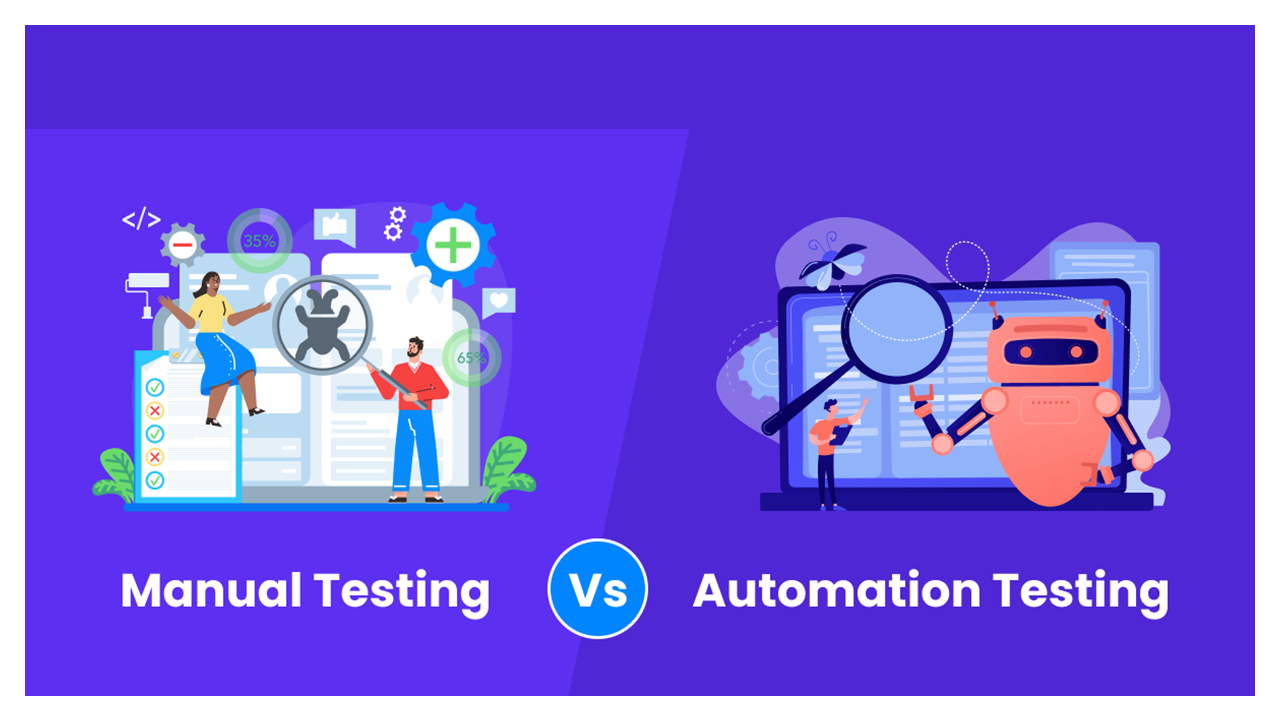
In the ever-evolving world of software development, quality assurance (QA) stands as the guardian of excellence. But when it comes to testing, a heated debate rages on: Manual Testing vs. Automation Testing. Which approach reigns supreme? Is one truly better than the other?
Imagine you’re at a crossroads, faced with a critical decision that could make or break your project’s success. On one path, you see the meticulous hands of manual testers, carefully examining every nook and cranny of your software. On the other, the efficient hum of automated scripts, tirelessly running tests at lightning speed. Both promise quality, but which one delivers the best results for your unique needs?
In this blog post, we’ll dive deep into the world of QA testing, unraveling the mysteries of manual and automation approaches. We’ll explore their strengths, weaknesses, and everything in between. From understanding the basics to analyzing cost factors, time efficiency, and scalability, we’ll equip you with the knowledge to make an informed decision. So, buckle up as we embark on this journey to discover which testing method truly holds the key to software excellence!
Understanding Manual Testing
A. Definition and key features
Manual testing is a software testing approach where human testers execute test cases without using automated tools or scripts. Key features include:
- Direct human interaction with the application.
- Real-time observation and interpretation of results.
- Flexibility to adapt tests on the fly.
- Reliance on tester’s experience and intuition.
B. Advantages of manual testing
Manual testing offers several benefits:
- Exploratory testing capabilities
- Accurate user experience evaluation
- Cost-effective for small-scale projects
- No coding skills required
| Advantage | Description |
| Flexibility | Testers can easily modify test cases based on observations |
| Human insight | Ability to detect subtle usability issues |
| Low initial setup cost | No need for expensive automation tools |
| Quick implementation | Can start testing immediately without script preparation |
C. Limitations of manual testing
Despite its advantages, manual testing has some drawbacks:
-
- Time-consuming for repetitive tasks
- Prone to human error
- Limited test coverage in large-scale projects
- Difficulty in simulating complex scenarios
D. Best scenarios for manual testing
Manual testing is particularly effective in the following situations:
- User interface testing
- Usability testing
- Ad-hoc testing
- Early-stage development
- One-time or infrequent test cases
Now that we’ve explored manual testing, let’s move on to understanding automation testing and its unique characteristics.
Exploring Automation Testing
A. What is automation testing?
Automation testing is the process of using specialized software tools to execute pre-scripted tests on a software application. This approach allows testers to create test scripts that can be run repeatedly with minimal human intervention. Automation testing is particularly useful for repetitive tasks, regression testing, and scenarios that require consistent and rapid execution.
B. Benefits of automated testing
Automated testing offers several advantages over manual testing:
- Increased efficiency
- Improved accuracy
- Faster feedback loops
- Cost-effective in the long run
- Ability to handle complex test scenarios
| Benefit | Description |
| Efficiency | Can run tests 24/7 without human fatigue |
| Accuracy | Eliminates human error in repetitive tasks |
| Feedback | Provides quick results for faster development cycles |
| Cost | Initial investment pays off with repeated test execution |
| Complexity | Can handle intricate test scenarios with ease |
C. Challenges in implementing automation
While automation testing offers numerous benefits, it also comes with its own set of challenges:
- High initial setup costs
- Requires specialized skills and expertise
- Maintenance of test scripts can be time-consuming
- Not suitable for all types of testing (e.g., usability testing)
D. Ideal use cases for automation
Automation testing is particularly well-suited for:
- Regression testing
- Load and performance testing
- Data-driven testing
- Cross-browser and cross-platform testing
- Repetitive tasks in large-scale projects
Now that we’ve understood both manual and automation testing, let’s do a quick comparison wherein we figure out the key differences between them.
Key Differences Between Manual and Automation Testing:
| Feature | Manual Testing | Automation Testing |
| Speed | Slow | Fast |
| Accuracy | Prone to human error | High accuracy |
| Cost | Low initial cost, but expensive in the long run | High initial cost, but cost-effective for long-term |
| Best Use Cases | Exploratory, usability, ad-hoc testing | Regression, performance, and load testing |
| Technical Expertise | Not required | Required |
When to Use Manual Testing vs. Automation Testing?
🔹 Use Manual Testing When:
- The project is small and short-term.
- Testing requires human judgment, such as UI/UX testing.
- Exploratory or ad-hoc testing is needed.
🔹 Use Automation Testing When:
- The project is large and requires repeated test execution.
- Regression, performance, or load testing is required.
- Faster execution and scalability are needed.
Best Tools for Manual & Automation Testing
📌 Manual Testing Tools: JIRA, TestRail, Q-Test, Bugzilla
📌 Automation Testing Tools: Selenium, Cypress, Test Complete, Appium, JMeter
Final Verdict: Which One is Better?
There is no one-size-fits-all answer. The best approach depends on your project requirements. Ideally, a combination of both manual and automation testing—a hybrid approach—provides the best results. Manual testing ensures better user experience analysis, while automation testing improves efficiency and accuracy.
Conclusion
Both manual and automation testing play a crucial role in software quality assurance. While automation testing is a game-changer for speed and scalability, manual testing remains indispensable for human-driven test scenarios. Understanding when to use each approach will help in delivering high-quality, bug-free applications efficiently.